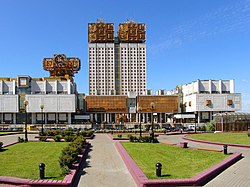
Back الأكاديمية الروسية للعلوم Arabic الاكاديميه الروسيه للعلوم ARZ Academia de Ciencies de Rusia AST Rusiya Elmlər Akademiyası Azerbaijani Рәсәй Фәндәр академияһы Bashkir Расійская акадэмія навук Byelorussian Расейская акадэмія навук BE-X-OLD Руска академия на науките Bulgarian Оросой Эрдэм Ухаанай Академи BXR Acadèmia de Ciències de Rússia Catalan
 | |
| Established | 8 February 1724 Saint Petersburg, Russia |
|---|---|
| President | Gennady Krasnikov[1] (since September 20, 2022) |
| Members | 1900 Russian + about 440 foreign, See also § Institutions |
| Address | Leninsky prospekt 14, Moscow |
| Location | Russia |
| Website | www |
Building details | |
 | |
 | |
The Russian Academy of Sciences (RAS; Russian: Росси́йская акаде́мия нау́к (РАН) Rossíyskaya akadémiya naúk) consists of the national academy of Russia; a network of scientific research institutes from across the Russian Federation; and additional scientific and social units such as libraries, publishing units, and hospitals.
Peter the Great established the academy (then the St. Petersburg Academy of Sciences) in 1724 with guidance from Gottfried Leibniz.[2] From its establishment, the academy benefitted from a slate of foreign scholars as professors; the academy then gained its first clear set of goals from the 1747 Charter.[2][3] The academy functioned as a university and research center throughout the mid-18th century until the university was dissolved, leaving research as the main pillar of the institution.[2] The rest of the 18th century continuing on through the 19th century consisted of many published academic works from Academy scholars and a few Academy name changes, ending as The Imperial Saint Petersburg Academy of Sciences right before the Soviet period.[2][4]
Now headquartered in Moscow, the academy (RAS) is a non-profit organization established in the form of a federal state budgetary institution[5] chartered by the Government of Russia. In 2013, the Russian government restructured RAS, assigning control of its property and research institutes to a new government agency headed by Mikhail Kotyukov.
As of November 2017[update], the academy included 1,008 institutions and other units;[6] in total about 125,000 people were employed of whom 47,000 were scientific researchers.[7]
- ^ "Gennady Krasnikov elected new President of the Russian Academy of Sciences". Novye Izvestia. 2022-09-20.
- ^ a b c d Cite error: The named reference
:1was invoked but never defined (see the help page). - ^ Cite error: The named reference
:02was invoked but never defined (see the help page). - ^ Cite error: The named reference
:3was invoked but never defined (see the help page). - ^ General information about the Academy. (in Russian).
- ^ Official list of units under jurisdiction of the Federal Agency for Scientific Organizations (these are units of RAS), 27 October 2017, in Russian.
- ^ Report of the Federal Agency for Scientific Organizations Archived 2017-04-03 at the Wayback Machine (number of employees: page 8), 20 March 2017, (in Russian).